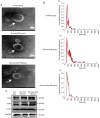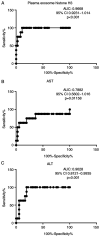Prognostic value of plasma exosomal levels of histone H3 protein in patients with heat stroke
- PMID: 34335883
- PMCID: PMC8290468
- DOI: 10.3892/etm.2021.10354
Prognostic value of plasma exosomal levels of histone H3 protein in patients with heat stroke
Abstract
Heat stroke (HS) is a condition that can lead to multiple organ dysfunction syndrome and death; however, there is no reliable method for stratifying mortality risk in HS. The abundance of exosomes in the circulation and their contents may be used as potential biomarkers of HS. The present study aimed to examine whether histone H3 levels in plasma exosomes could be used to determine HS prognosis. Blood samples were collected from patients with HS (36 survivors and 8 non-survivors) at admission to the intensive care unit and 4 days after admission. Blood samples were additionally collected from 15 healthy volunteers. Plasma exosomes were isolated using high-speed differential centrifugation. Correlation between histone H3 level and organ function and disease severity was examined. The results suggested differential expression and enrichment of histone H3 in the plasma exosomes of patients with HS (survivors, 249.3±04.6; non-survivors, 500.4±216.8; healthy controls, 161.1±52.49 pg/100 µg; P<0.05). The increased expression of histone H3 was associated with increased disease severity and duration. Plasma exosomal levels of histone H3 were significantly correlated with both organ dysfunction and disease severity (P<0.0001) and were significantly different between non-survivors and survivors (area under the receiver operating characteristic curve, 0.9668). A cutoff value of 307 pg/100 µg demonstrated optimized sensitivity (95%) and specificity (91.67%) for predicting mortality risk, suggesting that histone H3 levels in plasma exosomes may be a reliable biomarker for HS prognosis.
Keywords: biomarker; exosome; heat stroke; histone; multiple organ failure.
Copyright: © Li et al.
Conflict of interest statement
The authors declare that they have no competing interests.
Figures



Similar articles
-
Proteomic profiling of serum exosomes reveals acute phase response and promotion of inflammatory and platelet activation pathways in patients with heat stroke.PeerJ. 2023 Dec 13;11:e16590. doi: 10.7717/peerj.16590. eCollection 2023. PeerJ. 2023. PMID: 38107577 Free PMC article.
-
Increased serum exosomal miR-134 expression in the acute ischemic stroke patients.BMC Neurol. 2018 Dec 4;18(1):198. doi: 10.1186/s12883-018-1196-z. BMC Neurol. 2018. PMID: 30514242 Free PMC article.
-
Elevated plasma histone H4 level predicts increased risk of mortality in patients with sepsis.Ann Palliat Med. 2020 May;9(3):1084-1091. doi: 10.21037/apm-20-1011. Epub 2020 May 14. Ann Palliat Med. 2020. PMID: 32434363
-
[Prediction value of plasma histone in prognosis of sepsis patients].Zhonghua Wei Zhong Bing Ji Jiu Yi Xue. 2019 Jun;31(6):674-679. doi: 10.3760/cma.j.issn.2095-4352.2019.06.003. Zhonghua Wei Zhong Bing Ji Jiu Yi Xue. 2019. PMID: 31315721 Chinese.
-
Circulating exosomal CPNE3 as a diagnostic and prognostic biomarker for colorectal cancer.J Cell Physiol. 2019 Feb;234(2):1416-1425. doi: 10.1002/jcp.26936. Epub 2018 Aug 5. J Cell Physiol. 2019. PMID: 30078189
Cited by
-
Serum procalcitonin levels are associated with rhabdomyolysis following exertional heatstroke: an over 10-year intensive care survey.World J Emerg Med. 2024;15(1):23-27. doi: 10.5847/wjem.j.1920-8642.2024.02.009. World J Emerg Med. 2024. PMID: 38188547 Free PMC article.
-
Neurodegenerative Disease-Associated TDP-43 Fragments Are Extracellularly Secreted with CASA Complex Proteins.Cells. 2022 Feb 2;11(3):516. doi: 10.3390/cells11030516. Cells. 2022. PMID: 35159325 Free PMC article.
-
The role of microglial exosomes in brain injury.Front Cell Neurosci. 2022 Nov 8;16:1003809. doi: 10.3389/fncel.2022.1003809. eCollection 2022. Front Cell Neurosci. 2022. PMID: 36425666 Free PMC article. Review.
-
Inflammation, coagulation, and cellular injury in heat-induced shock.Inflamm Res. 2023 Mar;72(3):463-473. doi: 10.1007/s00011-022-01687-8. Epub 2023 Jan 7. Inflamm Res. 2023. PMID: 36609608 Review.
-
Biomarkers of heatstroke-induced organ injury and repair.Exp Physiol. 2022 Oct;107(10):1159-1171. doi: 10.1113/EP090142. Epub 2022 Jun 14. Exp Physiol. 2022. PMID: 35654394 Free PMC article. Review.
References
LinkOut - more resources
Full Text Sources
